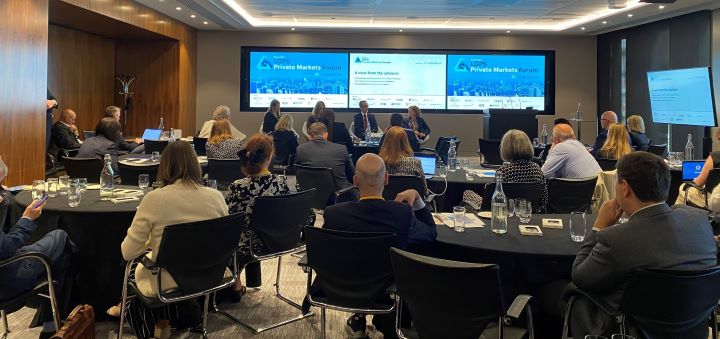Room151’s first Private Markets Forum drew a crowd of more than 60 LGPS investors to discuss investments in unlisted assets at an auspicious time, amid stickier than expected UK inflation figures and further Bank of England rate hikes, while possible sources of diversification were also addressed.
The event was opened by Aoifinn Devitt, CIO at Moneta, who challenged the audience to develop a forward-looking perspective on the asset class.
Adil Manzoor, senior portfolio manager, alternatives and monitoring at Merseyside Pension Fund, kicked off the first panel discussion of the day by stating that the fund plans to increase its allocations towards private markets.
Merseyside Pension Fund, which is valued at £11bn, currently has an asset split of 60% in public markets and 40% in private markets. This is above the average allocation of LGPS funds, which is at around 20% of assets held in private markets.
Manzoor said: “Within private markets, our focus will be more towards income generation. This is because we are a mature pension scheme, which means we have more pension payments going out than contributions coming in. So, we constantly need to look for yields and this presents a good opportunity.”
David Spreckley, head of pensions and treasury at the London Borough of Barnet, stated that the authority’s pension fund will also be looking to increase assets within private markets in the future.
For Spreckley, part of the appeal of private markets is the opportunity to achieve impact more directly than in listed markets. “I think we’ll be searching more on the impact and net zero side within private markets, as this is an area where we are searching for solutions. We’re probably more likely to find those solutions in the private space opposed to the public space,” he added.
Leandros Kalisperas, chief investment officer at West Yorkshire Pension Fund, agreed with Spreckley’s point that the private markets space allows pension funds to achieve impact, especially on the energy transition.
However, he warned that there are risks associated with reallocating capital away from public markets and towards private markets. Kalisperas said: “I am nervous about reallocation assets, but you have to be nervous if you’re going to invest in the sort of things that are going to make an impact; we have to be able to take those risks.”
_____________________________________________________________________________________
Room151’s 4th LGPS Investment Forum
8th November, 2023, London FREE for LGPS Practitioners
_____________________________________________________________________________________
Secondaries – concentrated buy side
The debate then moved to secondaries, which much like the broader asset class has seen a significant influx of assets. David Atterbury, managing director at HarbourVest, argued that the growth of the secondary market was in large part driven by the rapid growth of private markets, with assets then changing hands in the secondary markets. “There has been a real influx of opportunities,” he said.
But Atterbury also warned that on the buy-side, the market was heavily concentrated: “When you read the headlines, some very large funds have been raised but the big buyers account for some 50-60% of that, so on the buy side the market is relatively undercapitalised. There is about a year [to 18 months] of dry powder in the secondaries market right now,” he added.
Adi Bhagwat, principal, strategic equity at ICG, drilled down the debate with a focus on GP-led transactions, which have seen a near fivefold increase since 2017. This growth has been led by GP-led adoptions, Bhagwat said. “As this is still a relatively nascent market, there is insufficient GP-led capital relative to the opportunities,” he added.
GP-led transactions can play a role in liquidity provision at a time when liquidity in LP-led transactions has somewhat dried up, due to LPs not selling assets, Bhagwat argued.
But William Bourne, an independent advisor at Linchpin Advisory, drew the audience’s attention to some of the potential challenges of investing in secondaries.
He acknowledged that liquidity was a perk of the asset class but also warned that for investors who were selling, valuations could be a key challenge. “Exit valuations are currently down 40-50% or more, with an example being Revolut Bank,” he warned.
Another concern for Bourne was levels of cash that have not been placed yet. “Lots of dry powder always worries me. Prices in primary markets have gone up and leverage has gone up, so there is lots of room for disappointment: make sure you underwrite properly,” he recommended.
Keynote speech – focus on income
In the keynote speech, Edward Palmer, partner, CIO and head of sustainability at AlphaReal, outlined how the improved funding position of LGPS schemes due to the rise in gilt yields combined with persistently high inflation has led to a renewed focus on income generation.
He argued that in shifting their focus to secure income in private markets, LGPS investors could potentially establish a a tool to meet liability cashflows whilst benefiting from inflation-linked returns.
Private credit – a golden era?
Bruce Richards, CEO and chairman at Marathon Asset Management, kicked off the second round of debates on opportunities in private credit. He argued that the hike in rates and equity market volatility introduced what he called “a golden era of credit”.
Richards said that the coming wave of defaults as a result of rate hikes represented an opportunity for private credit investors.
Lei Lei, co-head European credit opportunities, alternatives at Ninety One, highlighted opportunities in asset-backed sponsorless markets, which he described as “less competitive”.
While the distressed debt and sponsored direct lending market has dozens of players, the sponsorless market is dominated by five or six players, he said.
“A key aspect of that was to remain selective on the assets to invest in: out of every 100 transactions we see, we only invest in two. We have to be selective because we don’t operate with a sponsor,” Lei Lei explained.
Trevor Castledine, managing director, private markets at bfinance and independent advisor South Yorkshire, responded by arguing that a lot of forecasts for credit margins had been optimistic.
“We are seeing forecasts of 5%, but that margin is going to be reset every quarter, so you have to be realistic about what your returns will be,” he warned.
This is the first instalment of our Private Markets Forum coverage, the second instalment will focus on ESG angles to investing in private markets.
Reporting by Mona Dohle and Aysha Gilmore.
—————
FREE weekly newsletters
Subscribe to Room151 Newsletters
Follow us on LinkedIn
Follow us here
Monthly Online Treasury Briefing
Sign up here with a .gov.uk email address
Room151 Webinars
Visit the Room151 channel














